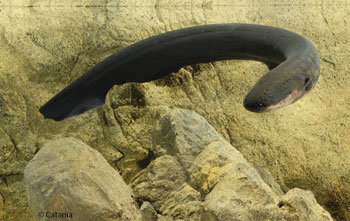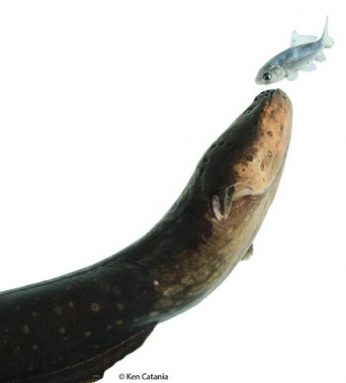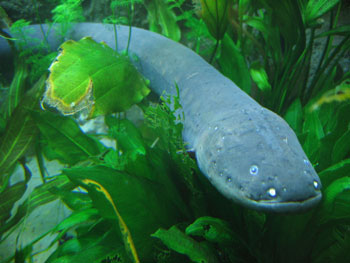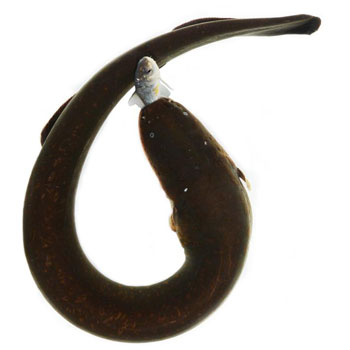The shocking electric eel!
This creature’s powerful jolts not only act like a radar system but also can trick its prey into revealing their location

The electric eel can deliver incredibly strong electric shocks. It uses these intense pulses to stun its prey.
Brian Gratwicke / Flickr (CC BY-NC 2.0)
By Roberta Kwok
Philip Stoddard once had a pet named Sparky. Sparky was an electric eel, a snake-like fish that can deliver incredibly strong electric shocks. It was sleek and dark gray, about 1.5 meters (5 feet) long, with tiny black eyes. Stoddard, a zoologist at Florida International University in Miami, kept Sparky in a tank in his lab.
One day, he felt tempted to touch the fish. “It was so beautiful, I had to pet it,” he says. Stoddard knew these eels produced intense electrical bursts when threatened. But he figured he and Sparky were friends. So he reached into the water and stroked the animal.
Big mistake.
Sparky immediately zapped Stoddard with about 500 volts of electricity. That’s roughly four times what he would get from the typical electrical outlet in a North American house. Stoddard’s arm hurt for the next hour. He says it was Sparky’s way of saying, “‘Don’t even think about it, Phil!’”
The electric eel is a fascinating creature. It lives in dark, murky South American rivers, such as the Amazon. The animal can’t see very well and it hunts at night. So it detects prey by emitting weak electrical pulses that act like radar. Then the eel stuns its prey with strong electrical blasts and sucks the animal into its mouth.
Stoddard has seen an electric eel demolish an entire school of fish. “He zaps them, and they all float to the surface,” he says. “Then he snarfles them down like popcorn as fast as he can.”
In the last two years, one scientist has published several intriguing findings about electric eels. Ken Catania, a biologist at Vanderbilt University in Nashville, Tenn., discovered that these animals use their electrical bursts to freeze prey in place. These eels can even force hiding fish to reveal their position.
Concludes Catania, “Everything I’ve seen in these animals is amazing.”
A sixth sense
Electric eels are part of a group of animals called electric fish. All have special organs that produce electrical pulses. Some species emit only weak pulses. Others emit strong pulses. The electric eel can do both.

An electric fish uses its weak pulses like radar. Those pulses create an electric field around its body. This acts like a bubble of electric current. When another animal enters that space, the fish detects a distortion in the electric field. That change helps it figure out the other animal’s position and identity — even when the water is dark or murky. “They have literally a sixth sense,” says James Albert. He’s a fish biologist at the University of Louisiana at Lafayette.
These fish get that sixth sense from organs called electroreceptors. These detect changes in the electric field. Electroreceptors look like little pits and cover the fish’s entire body.
Weak pulses also help the animals communicate. Electric fish change the rhythm and strength of their pulses to send different messages. These signals tell other electric fish lots of information, including the messenger’s sex, species and how aggressive it feels.
The strong electric pulse is a weapon. During an attack, a fish may zap its prey hundreds of times. In addition to electric eels, fish such as torpedo rays and African electric catfish also can release these intense blasts.
But the electric eel’s pulses are the strongest of all electric fish. “It is legendary,” Catania notes.
Freeze!
People have studied electric eels for a long time. Still, many mysteries have remained.
In 2014, Catania wanted to write a book chapter about these eels. Normally, he studies the sensory systems of animals such as moles, alligators and snakes. But he was fascinated by the way these eels sense electric fields.
So Catania got some eels for his lab. “I felt like if I was going to write about this creature, I wanted to get to know it a little better,” he explains.
First, he took videos of the eels hunting goldfish. He says, “I thought, what the heck: I gotta see when they attack a fish — what happens?” Electric eels attack very fast. So Catania used a high-speed camera that took 1,000 pictures per second. Then he replayed the recordings in slow motion.

Catania was intrigued. “How is that possible?” he wondered.
Perhaps the eel’s electrical blast acted like a Taser. This is a police weapon that releases electrical pulses. When the pulses hit a person, they trigger nerve cells called neurons. The activated neurons make the muscles contract so that the tased person can’t move.
To test his ‘tasing’ idea, Catania performed an experiment. He hooked up a dead goldfish to a device that recorded the animal’s muscle contractions. The fish had just died, so its muscles still worked.
Catania wanted to see how the fish’s muscles reacted to the eel’s pulses. But he didn’t want the eel to actually eat the fish, because that would mess up the muscle-contraction measurements. So he put the fish in a tank with an eel but separated the two with a barrier. Then he added some live earthworms to the eel’s section of the tank. The eel zapped the worms with hundreds of strong electrical pulses. The pulses penetrated the barrier to reach the dead fish.
Just as Catania expected, the goldfish’s muscles contracted as soon as the eel began releasing pulses. It looked like his hunch was correct. The electrical blast worked like a Taser: It froze the fish by making its muscles contract.
But Catania also noticed something odd. Rather than hundreds, sometimes the eel emitted just two strong pulses when swimming near the dead fish. Only afterward would it launch a full-scale barrage. That’s when it attacked its prey with hundreds of pulses and tried to break through the barrier.
Nowhere to hide
Catania’s first experiment showed that the eel’s bombardment with strong pulses froze its prey. So why had it released an isolated pair of pulses beforehand?
Hoping to find out, the scientist looked more carefully at those data on the goldfish’s muscle contractions. And he realized that its body had twitched right after the eel emitted the two pulses. He wondered if the eel’s little electrical burst had triggered the twitch.
The idea made sense. Imagine a small fish in a dark river at night. To avoid being eaten by an electric eel or some other predator, the fish hides in some plants. It stays very still, hoping the eel doesn’t notice it.

But gathering evidence for this idea was tricky. How could Catania show that the twitch allowed the eel to figure out the prey’s position? Maybe the the twitch wasn’t important. Those two pulses might just have been a warm-up for the full attack.
To find out, Catania devised another experiment. First, he hooked up another dead goldfish to a device called a stimulator. Through wires attached to the goldfish’s body, the device transmitted an electrical pulse that forced the fish to twitch.
Before Catania turned it on, he put the fish in a plastic bag. Plastic doesn’t conduct electricity very well. Here, then, the bag blocked the eel’s pulses.
Catania watched what happened when the stimulator was inactive and the fish stayed still. The eel gave off a pair of pulses, as usual. Since the plastic bag shielded the fish, it didn’t twitch. The eel didn’t attack the fish.
Then Catania used the stimulator to make the goldfish twitch after the eel’s two pulses. This time, the eel did attack. The result suggested that the fish needed those twitches to detect its prey.
In a way, the eel is performing “remote control” on the fish, says Catania. The eel can make the fish move without even touching it. It’s sort of like a Jedi from Star Wars using the Force to make people do things that they never meant to do.
“It’s just darn clever,” adds Stoddard.
Confused eels
Catania had uncovered some impressive eel strategies. But his work wasn’t over yet. Each experiment just raised another question.
SHOCKING SPEED This video shows how the eel’s electrical pulses first detect and then immobilize its prey (shown in speeds slower than life). In full-color sequences, knocklike sounds indicate electrical discharges from the eels. Black-and-white sequences have been colorized (red) to indicate when the eel is releasing electrical charges. Science News (with Catania footage) |
He noticed that when the fish in the plastic bag twitched, the eel lunged toward it to attack. But it didn’t end up biting the fish. It moved in the right direction, but then it gave up. “The fish is right there in front of them,” says Catania. “So what’s the deal there?”
Was the eel missing something crucial?
The fish’s twitch gave the eel a hint to its general location — like “I’m off to your right.” But maybe the eel needed more information to zero in on the exact spot.
Plus, the prey might move to a new location after it twitched. Even if the eel’s attack froze the fish’s muscles, it could still drift through the water. And eels don’t have good vision.
Catania wondered if the eel needed to track its prey using electrical pulses (which the plastic bag blocked). He knew that electric eels use their weak pulses as “radar” to detect prey. During an attack, though, the eel’s pulses switch from weak to strong. The animal can’t emit both types at the same time.
So Catania found himself wondering whether the eel also used its strong pulses as radar. That would be surprising. Scientists thought that eels used the strong pulse only as a weapon.
To find out, Catania repeated his experiment — but added a twist. He dropped a carbon rod into the tank. The rod would conduct electricity.
Catania used the stimulator to make the goldfish in the plastic bag twitch. But this time, something weird happened. The eel lunged toward the fish, but then it changed direction and attacked the carbon rod instead!
Why? The eel was releasing strong pulses to try to freeze its prey. But those strong pulses also acted as radar. The plastic bag shielded the goldfish from the radar, but the carbon rod was not as lucky. The eel detected the rod, thought that it was the prey and attacked that, instead.
Catania did many more experiments to make sure his idea was right. He put plastic rods in the tank along with the carbon rod. Since plastic doesn’t conduct electricity well, the eel’s radar couldn’t detect those rods. Sure enough, the eel ignored plastic ones, attacking only the carbon.

Then he put the carbon rod on a spinning disk to find out how well the eel could track a fast-moving object. The eel chased and struck the moving rod.
Catania also did the experiments in the dark, using only infrared light. The eel couldn’t see anything in that type of light, yet it still behaved the same way. So vision wasn’t that important in the eel’s hunt.
All the experiments suggested that the electric eel relies on its strong electrical bursts to track prey. In other words, the strong pulses are both a weapon and a sensory system. “It’s like having laser vision,” says Catania. Think about a cartoon character that uses its eyes to see but also to shoot deadly laser beams. That’s sort of what the eel is doing with its zaps.
A sophisticated hunter
Catania had put together a lot of puzzle pieces. He discovered that the electric eel first emits two pulses to make its prey twitch. Then it releases hundreds of strong pulses. The bombardment does two things at the same time: it freezes the prey’s muscles and helps the eel track the prey’s exact location.
These eels pull out all the stops to make sure they get their meal. “They’re even more sophisticated than we thought,” says Stoddard. “They’re not running purely on brute force.”
When Catania first brought electric eels into his lab, he never thought he would learn so much about them. He thought he might take some cool videos to show his students in class and write his book chapter. “Instead, I ended up stumbling into this thing that was just so interesting that I had to pursue it,” he says. Every time he watched the eels closely, a new question arose — and he wanted to answer it.
Unlike Stoddard, Catania has not yet been shocked by a big electric eel, only small ones. “I’m very curious,” he admits. But he has decided that he doesn’t need to know first-hand what the full force of an electric eel attack feels like. That’s one question he’ll leave unanswered.
Word Find (click here to enlarge for printing)








